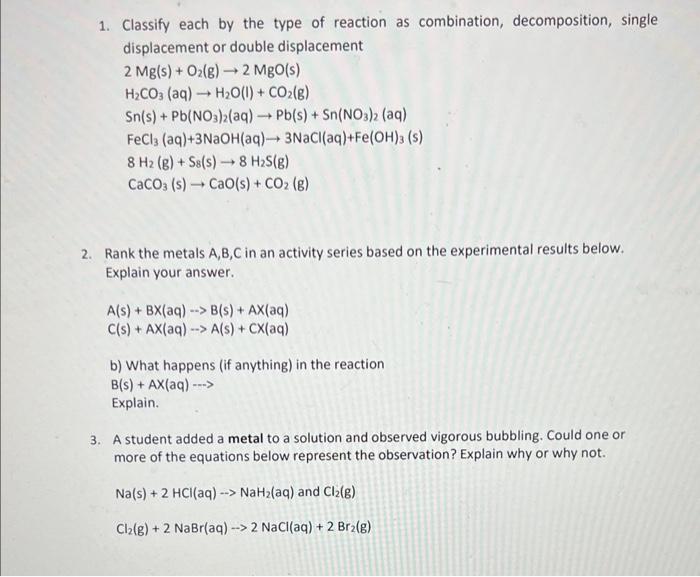Answered step by step
Verified Expert Solution
Question
1 Approved Answer
question 1. Classify each by the type of reaction as combination, decomposition, single displacement or double displacement 2Mg(s)+O2(g)2MgO(s)H2CO3(aq)H2O(l)+CO2(g)Sn(s)+Pb(NO3)2(aq)Pb(s)+Sn(NO3)2(aq)FeCl3(aq)+3NaOH(aq)3NaCl(aq)+Fe(OH)3(s)8H2(g)+S(s)8H2S(g)CaCO3(s)CaO(s)+CO2(g) 2. Rank the metals A,B,C in an
question 
1. Classify each by the type of reaction as combination, decomposition, single displacement or double displacement 2Mg(s)+O2(g)2MgO(s)H2CO3(aq)H2O(l)+CO2(g)Sn(s)+Pb(NO3)2(aq)Pb(s)+Sn(NO3)2(aq)FeCl3(aq)+3NaOH(aq)3NaCl(aq)+Fe(OH)3(s)8H2(g)+S(s)8H2S(g)CaCO3(s)CaO(s)+CO2(g) 2. Rank the metals A,B,C in an activity series based on the experimental results below. Explain your answer. A(s)+BX(aq)B(s)+AX(aq)C(s)+AX(aq)A(s)+CX(aq) b) What happens (if anything) in the reaction B(s)+AX(aq) Explain. 3. A student added a metal to a solution and observed vigorous bubbling. Could one or more of the equations below represent the observation? Explain why or why not. Na(s)+2HCl(aq)NaH2(aq)andCl2(g)Cl2(g)+2NaBr(aq)2NaCl(aq)+2Br2(g) 
Step by Step Solution
There are 3 Steps involved in it
Step: 1

Get Instant Access to Expert-Tailored Solutions
See step-by-step solutions with expert insights and AI powered tools for academic success
Step: 2

Step: 3

Ace Your Homework with AI
Get the answers you need in no time with our AI-driven, step-by-step assistance
Get Started


